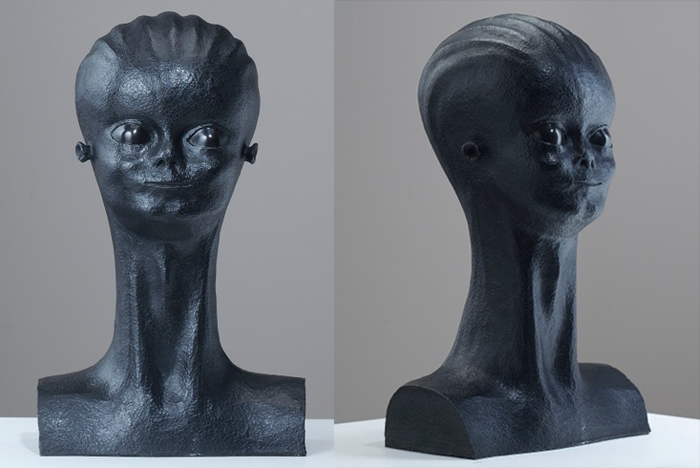In front of me are two sculptures by Robert Llimos, of Alfa and Beta, a couple from the universe. These quasi-reptilian extraterrestrials constitute a unique “space-anthropological” reconstruction in painted terra cotta and bronze. The first impression is one of beauty and calm, the two beings looking thoughtful and intelligent with their elongated necks and big almond reptilian eyes. They have very small ears and no hair, a metallic tiara and scaly skin lending a quasi-aquatic countenance.
This is no mere expression of interstellar imagination, but rather a documentation of a close encounter. It took place in the summer of 2009, while Robert Llimos, a 65-year-old second-generation painter from Barcelona, was diligently working on a landscape while on the beach in Fortaleza, Brazil. As he explained to me, he had come to Brazil to attend his girlfriend Marina’s brother’s wedding, and now, finding the sand uncomfortably hot, he placed his flip-flops in his back pockets to cushion the heat while he sat.
Fortaleza, Brazil’s second-largest city has a typically tropical dry climate with high temperatures and relative high humidity for six months of the year. These conditions usually are moderated by pleasant winds blowing from the ocean, which allow for activities such as surfing, kite flying, and now kite-surfing. On this day there was no one on the beach or on the water.
Glancing up at the clouds, Llimos saw some odd colored lights, which he quickly rendered on paper using watercolors. Then a humanoid figure appeared in the sky, shaped by dark clouds, that seemed to be trying to hypnotize him, but Llimos averted his eyes and focused on the paper upon which he was sketching. He found himself recording the glowing letters N and Z floating over the water.
Suddenly, an enormous metallic ship materialized. It was shaped like a disc, and at first Llimos took it to be an electronic projection or hologram, but then he could see vapor coming from vents inside its body. An observatory platform with columns and windows arranged in a circular pattern slowly descended from the belly of the ship, with what resembled a large telescope poking out. The telescope seemed to regard Llimos with curiosity. Next one of the windows opened, and two ETs appeared against a glowing yellow background.
Suddenly, Llimos found himself being scanned with a green light and somehow transported closer to, or even inside the UFO, but here his memory fails him because he cannot account for the many hours he subsequently went missing. After a while, various friends and family of Marina’s went up and down the beach to look for the missing artist, until Marina discovered him walking with eyes wide open and ecstatically claiming “I was on the ship! I saw them!”
They reported the incident to the local police, and the commandant took the news without surprise, noting that there are similar sightings in Fortaleza almost every year. (I can recall that several years ago an Air-France airbus flying at 30,000 feet over Fortaleza went into the ocean for no evident reason with 350 people on board.)
Analyzing the work Llimos produced before, during and after his encounter, I have to conclude that his documentary-like talent did what it always did: It preserved a moment of reality in graphic, artistic terms.
Llimos’ watercolors are moody and post-impressionistic, with exotic tints depicting the first image of the UFO coming into vision from the clouds. His black-and-white etchings are extremely detailed and depict his space couple studying him with the same curiosity he had for them. One might call his work a case of space anthropology, depicting the detailed elements of a new species that perhaps already has become intra-terrestrial (Llimos says some of the aliens are living underwater or in the arctic region, inaccessible to man).
A year after the encounter, a public art show at the Alexandro Sales Gallery in Barcelona displayed Llimos’ new work, during which time he says the aliens tried to contact him on his cell-phone six times, using high-pitch voices that he translated variously as happy or sad based on pitch of tone. After almost a year of intermittent contact, the voices and visions left Llimos’ sphere of perception.
It took the artist almost four years to create a complete series of sculptures and paintings to commemorate his experience. The bronze sculptures are the newest and most serious, reminding us of Henry Moore’s “King and Queen” works of aristocratic refinement. Llimos approaches his space-muses with affection and gives them an essence of pride and dignity.
Llimos’ visions are nothing short of alchemical magic that opens a window into his creative process and, perhaps, extends an open invitation for his curious, benign otherworldly subjects to return.
by Valery Oisteanu
























